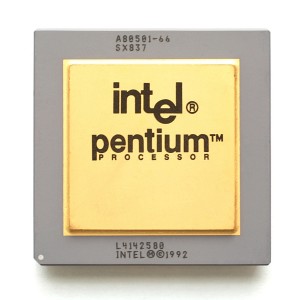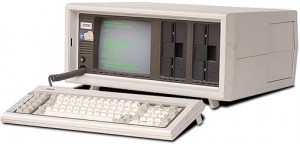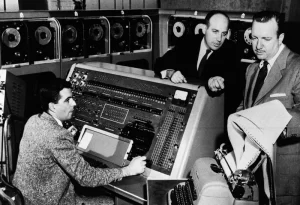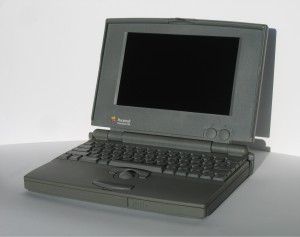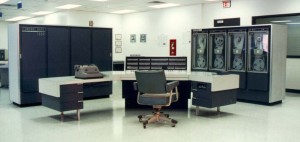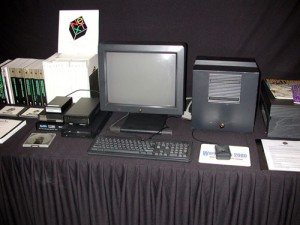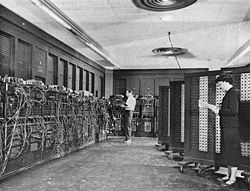Computers
Intel Bugs Out
One week after reports surfaced identifying a flaw in certain Pentium processors, Intel releases a software workaround for operating systems to avoid the commonly named “F0 bug“. A very specific invalid operation passed to the affected processors would cause the processor to lock up, causing the computer and any software running on it to freeze. Identified by Intel as the “Invalid Operand with Locked Compare Exchange 8Byte (CMPXCHG8B) Instruction Erratum” (seriously?), the flaw, while potentially a serious problem, was practically little more than a PR headache as the invalid operation that triggered the processor to lock up was never encountered in real-world operations. Additionally, the F0 bug only affected the older Pentium processors, not the Pentium II and Pentium Pro processors Intel was currently shipping at the time. However, the workaround was necessary as malicious software could have exploited the flaw and caused serious problems for PCs and servers using the affected processors.
Ethernet is Born
November 11, 1973
As invented by Robert Metcalfe and David Boggs, an Ethernet network functions for the first time. From it’s humble beginnings as a research project at Xerox PARC, Ethernet has developed into the de facto standard for business and home networking.
IBM Signs A Deal With The Devil
IBM and Microsoft formally sign an contract whereby Microsoft will create an operating system for the in-development IBM PC. During the summer of 1980, IBM was originally interested in licensing the popular CP/M operating system, but the inability to come to an agreement with Digital Research led IBM to ask Microsoft if they could develop an operating system similar to CP/M. Microsoft was already going to work with IBM to deliver their BASIC programming language for the IBM PC, but they did not have an operating system. However, Microsoft knew that a small company named Seattle Computer Products had developed an operating system similar to CP/M called QDOS, for Quick-and-Dirty Operating System. Microsoft suggested to IBM that QDOS could work as the IBM PC’s operating system. IBM asked Microsoft to license and further develop the operating system, which led to the formal contract on November 6, 1980. After the contract was signed, in December 1980 Microsoft would license the QDOS operating system to begin development of the IBM PC version. In July of 1981, just weeks before the IBM PC would ship, Microsoft purchased full rights from SCP for what was now called 86-DOS. IBM PC-DOS was the name of the operating system that would ship on the IBM PC, but it was Microsoft that wholly developed the operating system after acquiring it from SCP.
Microsoft shrewdly included a clause in the agreement that allowed them to sell the operating system to other companies under the name MS-DOS. It was this clause that changed the course of technology history, opening the door for Microsoft to become the dominant technology company of the PC era. Microsoft seemed to understand that by controlling the operating system, the underlying hardware became less relevant. IBM obviously did not consider this concept, nor did they foresee that companies would be able to successfully clone their hardware platform. Once companies were able to clone the hardware, they needed an operating system. Microsoft was more than happy to provide them with that operating system, which by design was completely compatible with IBM’s PC-DOS. Once IBM lost control of the platform they created, power shifted to the one major commonality between the IBM-compatible clones: Microsoft’s operating system. It was IBM’s name that pushed the IBM PC into prominence, but it was the combination of hardware cloning and Microsoft licensing the operating system that created the dominant platform of the PC era, crushing nearly all competing personal computer platforms in the process. Without this seemingly minor clause in this pivotal contract, the history of the PC era could have been quite different than it was.
Attack of the Clones
Compaq announces their Compaq Portable PC, one of the early portable computer designs and, more significantly, the first successful IBM-compatible PC clone. Compaq eventually succeeded where other similar companies failed because they took considerable care in creating their product on two fronts. First, they created the first 100% IBM-compatible BIOS, the only proprietary component of the IBM PC. Spending $1 million to reverse engineer the IBM BIOS using clean-room techniques, this also allowed them to avoid copyright infringement charges. Finally, they were legally and financially prepared for the inevitable lawsuit IBM would bring against then, which was dismissed as expected.
By proving that a clean room, reverse-engineered BIOS could create 100% IBM-compatible computers and withstand legal challenges from IBM, Compaq paved the way for the flood of IBM-compatible clones that would begin in the mid-1980’s. This was the opening of the Pandora’s Box that led to IBM losing control of the platform, and the emergence of Microsoft and Intel as the dominant technology companies of the PC era. Even though IBM lost control of the platform they created, the weight of the IBM name combined with the eventual low cost of the IBM-compatible platform crushed nearly all other competing personal computing platforms of the era.
Computer First Predicts Presidential Election
As part of a publicity stunt to help boost sales, Remington Rand collaborates with CBS to have its UNIVAC computer predict the results of the 1952 US presidential election between Dwight Eisenhower and Adlai Stevenson live on air. Because the pre-election polls had the election very close, the publicity surrounding a computer predicting the winner generated a lot of popular interest.
UNIVAC correctly predicted a landslide victory by Eisenhower early in the evening after only 3 million votes had been returned and entered into the system. However, because it was so different than the expected result, the decision was made to hold back the computerized prediction. It appears that both Remington Rand and CBS feared the computer was incorrect so they didn’t want to take the risk. It was only late in the broadcast when continuing returns seemed to indicate that UNIVAC was in fact correct, did CBS announce the landslide prediction from the computer and the fact it had done so hours earlier. In the end, UNIVAC had come within 3.5% of the popular vote, within 4 electoral votes, and predicted 100-1 odds of the Eisenhower victory.

Apple Introduces PowerBook
At the COMDEX computer expo in Las Vegas, Apple introduces the first line of PowerBook notebook computers, the PowerBook 100, PowerBook 140, and PowerBook 170. The first truly portable Macintosh, the PowerBook line redefined portable computing and set the bar for future laptop designs. For example, the PowerBooks were the first laptop to have a trackball positioned in front of the keyboard. Most existing PC laptops of the time ran DOS and were therefore keyboard-oriented, requiring the use of external mice.
VisiCalc Officially Released
According to Dan Bricklin, the first “real” release of VisiCalc was completed and packaged for shipment. VisiCalc was the first commercially available spreadsheet software and quickly became the first “killer app” of the personal computer market.
CDC 1604 Released
Control Data Corporation (CDC) releases their CDC 1604 computer, the world’s fastest computer at the time and the first commercially successful fully-transistorized computer. The 1604 was CDC’s first computer, primarily designed by engineer Seymour Cray, who would later go on to found Cray Research and be called the “father of the supercomputer”.
Steve Jobs’ NeXT Computer
Hailed by Steve Jobs as a computer “five years ahead of its time”, NeXT, Inc. introduces their NeXT Computer. Due to its cube-shaped case, the computer was often referred to as “The Cube” or “The NeXT Cube”, which led to the subsequent model offically being named “NeXTcube“. The new computer introduced several innovations to personal computers, such as including an optical storage disk drive, a built-in digital signal processor for voice recognition, and an object-oriented development environment that was truly years ahead of its time.
While not a commercial success, the NeXT Computer and the technology developed for it have a long and storied history. Tim Berners-Lee developed the first world wide web server and web browser on a NeXT computer, crediting the NeXT development tools for allowing him to rapidly develop the now ubiquitous Internet system. After Apple purchased NeXT in 1997, they used the operating system of the NeXT computers to form the base of Mac OS X. Eventually Apple’s iOS, which runs the iPhone and iPad, was itself based upon Mac OS X and hence draws its lineage to NeXT. Finally, the object-oriented development environment that Berners-Lee used to create the World Wide Web is the forerunner of the development environment that today’s programmers use to develop iPhone and iPad Apps. If it wasn’t for the NeXT Computer back in 1988, many of the technologies we make use of today may have evolved very differently.
ENIAC Retired
Considered the world’s first fully electronic computer, after eleven years of continuous service the ENIAC computer was retired from service.

